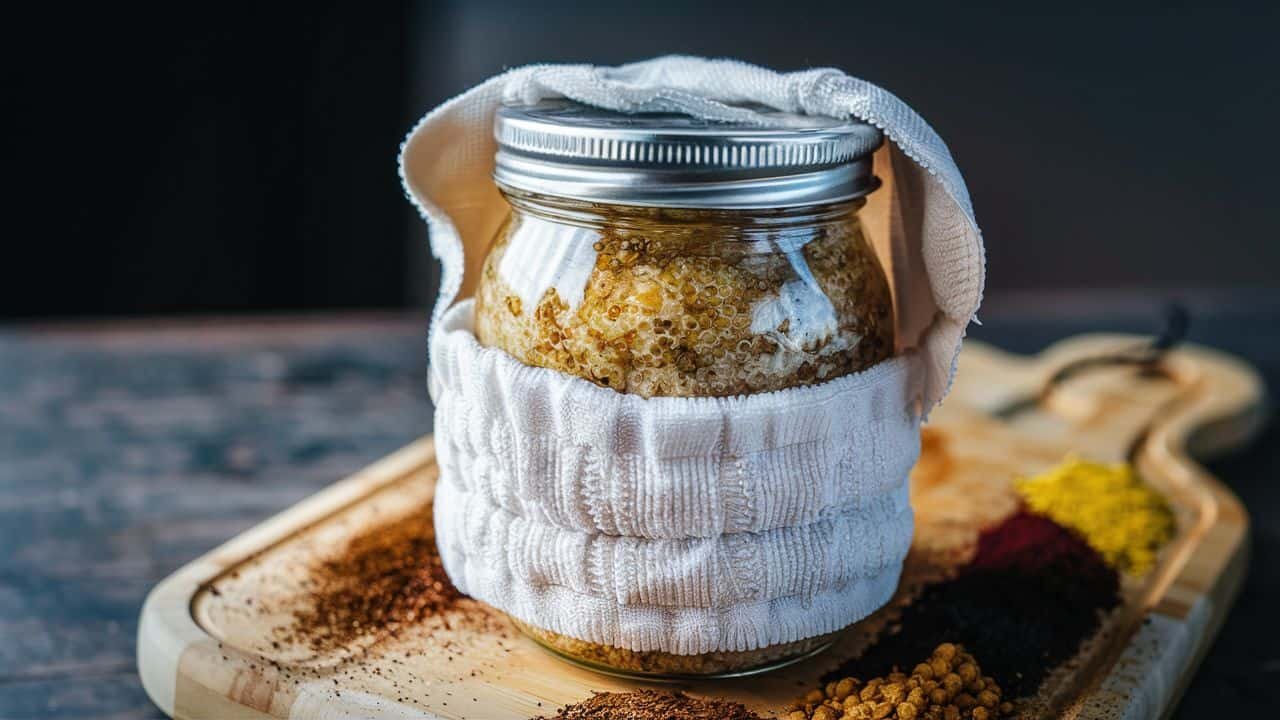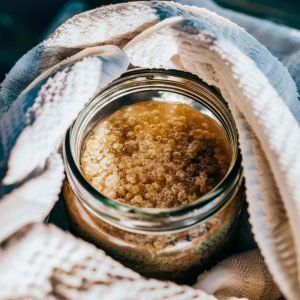How To Make Fermented Quinoa (Recipe)

Did you know that quinoa, often hailed as a superfood, was so valued by the Incas that they called it the “mother of all grains”?
Despite its recent popularity worldwide, this nutrient-packed seed has been fueling ancient civilizations for thousands of years. Now, imagine unlocking even more of its nutritional benefits through fermentation.
If you’ve clicked on this article, chances are you’re curious about how to make fermented quinoa but might be tired of sifting through endless paragraphs before getting to the actual recipe in most food blogs. We get it; sometimes, all those extra details feel like a maze when you just want clear instructions.
The good news? You’re in the right place! In this article, we’ll dive straight into teaching you how to ferment quinoa at home in an easy-to-follow manner. No fluff or fancy words – just simple steps and practical tips.
Fermented Quinoa Recipe

Fermented Quinoa
Equipment
- 1 Medium-sized cooking pot
- 1 Wooden spoon
- 1 Glass jar with lid quart-size works well
- 1 Cheesecloth or clean kitchen towel
Ingredients
- 1 cup uncooked quinoa
- 1/2 tsp salt
- 2 cups water for cooking.
- 1 cup Kombucha
Instructions
- Rinse your quinoa thoroughly under cold water to remove any saponins that can give it a bitter taste.
- Combine the rinsed quinoa with two cups of water in your medium-sized cooking pot and bring it to a boil over medium-high heat.
- Reduce the heat to low, cover the pot with a lid slightly askew allowing some steam to escape and simmer until all water is absorbed — about 10 – 15 minutes.
- Remove from heat and let cool down completely at room temperature
- Once cooled, stir in salt evenly through the cooked quinoa
- Transfer your seasoned quinoa into your glass jar leaving at least one inch of space from the top.
- Pour over the Kombucha.
- Stir the mix together
- Cover loosely with cheesecloth or kitchen towel secured with a rubber band around the rim of the jar – this allows air exchange necessary for fermentation while keeping out contaminants.
- Let sit at room temperature away from direct sunlight in a relatively warm spot for one day up till two days depending on how tangy you prefer it—taste test after day one.
- After reaching desired sourness level replace cheesecloth/kitchen towel with jar's lid and store fermented quinoa in refrigerator where it will keep well up till five days enhancing flavors each day.
Video
Notes
- Experiment by adding herbs like cilantro or parsley post fermentation before refrigerating which can enhance flavor profiles beautifully.
- Remember that exact ferment times may vary due to factors like ambient temperature.
- You can buy ready-made Kombucha on Amazon. Health-Ade’s Ginger Lovers Kombucha Tea is one of the best options.
- Instead of Kombucha tea, you can also use a culture starter. For example, this one by Body Ecology. Use 1 tablespoon.
Why Ferment Quinoa Anyway?
The main reason to ferment quinoa is to boost its nutritional value.
Fermentation helps break down substances in quinoa that can block your body from absorbing all the good nutrients it has to offer.
These substances are called “antinutrients,” which include phytic acid and saponins found in quinoa.
Phytic acid can bind to minerals like iron, zinc, magnesium, and calcium in the digestive tract, making them less available for your body to absorb.
Saponins, on the other hand, can cause a bitter taste and might irritate the gut lining if not properly rinsed off before cooking.
Fermentation helps reduce these antinutrients, improving both the nutritional value of quinoa and its digestibility.
This means after fermenting, you get more of the vitamins and minerals from quinoa than you would if you ate it unfermented. Plus, it’s a simple way to make your meals healthier without much extra work!
Health Benefits of Fermented Quinoa Vs Quinoa
While normal quinoa is already known for its high protein content, rich fiber levels, and abundance of vitamins and minerals, fermenting quinoa can “unlock” even more health benefits.
Here are the advantages of fermented quinoa compared to its non-fermented counterpart.
Enhanced Nutrient Absorption
The fermentation process reduces the presence of antinutrients like phytic acid in quinoa. Phytic acid can bind with minerals such as iron and zinc, making them less available for absorption by the body.
Fermented quinoa allows for better mineral absorption, ensuring you get more nutritional value from each serving.
Improved Digestibility
Fermentation introduces beneficial bacteria (probiotics) that aid in digestion. These probiotics help break down complex proteins and fibers in quinoa, making it easier on your stomach and reducing issues like bloating or discomfort often associated with consuming grains.
Increased Probiotic Content
Eating fermented quinoa adds helpful probiotics to your diet. These good bacteria are essential for maintaining a healthy gut microbiome, which plays a crucial role in everything from digestion to immune function. [1]
Enhanced Flavor Profile
For those looking to add variety to their meals, fermented quinoa offers a unique flavor not found in regular quinoa. This can enhance the taste of various dishes without needing extra seasoning or ingredients.
Longer Shelf Life
Fermented foods generally have a longer shelf life due to the preservation effect of lactic acid produced during fermentation. [2]
This means fermented quinoa can be stored longer than non-fermented varieties without losing its quality or nutritional value.
Which Type of Quinoa is Best For Fermentation?

When it comes to fermenting quinoa, you can actually use any type – white, red, black or even sprouted. They all have similar nutritional profiles and the fermentation process works well with each of them.
- White quinoa is often chosen because it’s the most common type and has a slightly softer texture when cooked.
- Red and black quinoa hold their shape better after cooking and offer a bit more crunch which some people prefer in their fermented dishes.
- Sprouted quinoa is another great option as sprouting itself already begins breaking down some of the antinutrients we talked about earlier. This could potentially make for an even smoother fermentation process.
So really, there’s no “best” type for everyone—it depends on your personal preference for taste and texture.
But if I had to pick one? I’d probably go with white quinoa because it’s easy to find and gives a nice soft texture that mixes well into different meals once fermented.
Is fermented Quinoa is very low in carbs?
Fermented quinoa isn’t very low in carbs, but here’s the scoop. Quinoa itself is a seed that’s known for being a good source of carbs. Even when you ferment it, the process doesn’t significantly reduce its carb content.
So, if you’re eating quinoa—fermented or not—you’re still getting a fair amount of carbs.
However, fermented quinoa does have some added benefits that make it a bit different from regular quinoa. The fermentation might help your body use those carbs better and improve digestion overall.
But in terms of numbers, don’t expect fermented quinoa to be a low-carb food. It’s more about making the most out of the nutritious carbs you are consuming by enhancing their digestibility and nutritional availability through fermentation.
History of Quinoa

Quinoa has a long and rich history. It was first grown and eaten by people living in the Andes Mountains of South America about 3,000 to 4,000 years ago. The Incas, one of the powerful civilizations in that area, valued quinoa so much they called it “chisaya mama,” which means “mother grain.”
When Spanish explorers arrived in South America in the 1500s, they didn’t understand how important quinoa was to the local people. They even tried to get rid of it because it was part of non-Christian religious ceremonies.
But quinoa survived high up in the mountains where other crops couldn’t grow well. For centuries, it remained a local food until around the late 20th century when its nutritional value started gaining global recognition.
Today, we know quinoa as a “superfood” loved by health enthusiasts all over the world for its high protein content and loads of other nutrients. Despite being used like a grain in cooking, quinoa is actually a seed from a plant called Chenopodium quinoa.
From ancient Andean fields to modern-day kitchens worldwide—quinoa sure has made quite an impressive journey!
Bottom Line
In a nutshell, fermenting quinoa is an easy and affordable way to boost its nutritional value and add a tangy twist to your meals.
Whether you’re new to fermentation or looking for your next kitchen adventure, this straightforward recipe has got you covered. Remember, any type of quinoa works great—choose what suits your taste best.
So why not give fermented quinoa a try? It’s all about making the most out of every bite by unlocking more nutrients and flavors from this ancient superfood!
Check More Recipes
